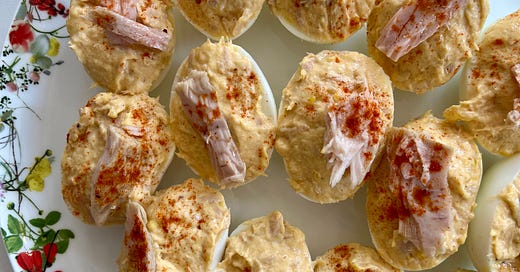With Easter approaching, I thought I would share with you one of my favorite recipes for deviled eggs. They make people happy any time you share them, but there’s something extra special—and extra practical—about them at Easter, when many of us might have some dyed eggs lying around!
If you know me, you know that I love history…and deviled eggs have a fascinating story. The term “deviled” in food was first used in the 18th century to refer to spicy or really flavorful dishes—the devil comes from somewhere very hot, so I guess it makes sense! Many places around the world have their own versions of deviled eggs—with or without spice—and in Spain, one of the ways we like to make our huevos rellenos is with tuna and mayonnaise. Maybe even the first person to make deviled eggs was a Spaniard…or at least the first person to write down the recipe, since the first cookbook mention of them came from 13th century Andalucía (though maybe the Romans had thought to stuff an egg earlier…?) In the US, a newspaper in Alabama published the earliest known American recipe in 1877, with butter, vinegar, cayenne, and mustard, and Fannie Farmer added mayonnaise to hers 20 years later.
There’s a religious connection to these eggs, as fish is of course common for Lent—another reason that it’s a perfect dish to make for Easter. I think that they’d be great for the Passover table next month, too!
This recipe comes from America Eats Tavern, my old restaurant dedicated to the history of American food. While it pays tribute to the traditional Spanish preparation with tuna, the Valentina hot sauce adds an extra bit of heat, making this dish truly American.
You can easily scale this recipe up—and feel free to adjust the hot sauce up or down, depending on how deviled you like your deviled eggs.
Deviled Eggs
Makes 16




